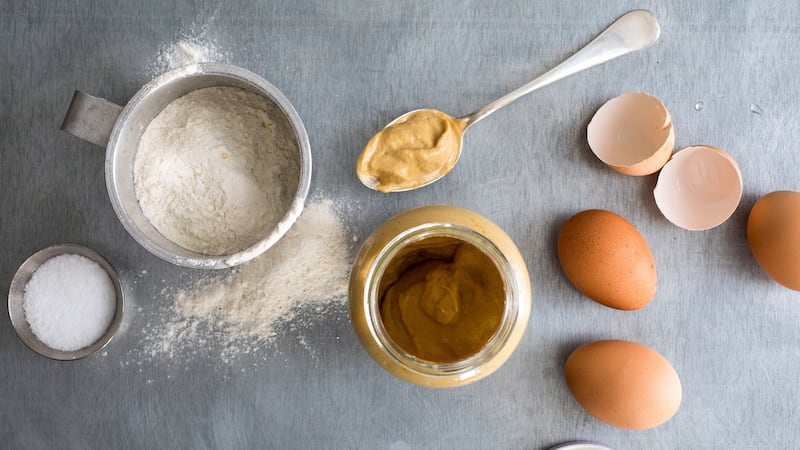It is England in the 1700s, and bits of meat are being thrown into a pot, their sizzling drippings cooking a thick batter that’s poured on top, making it puff up and crisp spectacularly. The batter, plus a good serving of gravy, transforms the random offcuts into a delicious, satiating meal.
The dish was first referred to quite literally, as “meat boiled in a crust”, or described as “batter pudding with a hole in the middle containing meat”. Later on sausage became the commonplace meat, and a more figurative name was given; with that, toad-in-the-hole, along with spotted dick and bubble and squeak, became one of Britain’s most popular (and peculiarly named) dishes.
Placing me in charge of making Yorkies was a dangerous move. They were so good that a nice proportion ended up feeding me instead of loyal customers

That batter is part of the meal that showed me, when I arrived in Britain, more than two decades ago, how good British food can be. The setting was a Sunday roast, served in the first restaurant that offered me a permanent job. The stars, alongside the meat, were the aforementioned gravy, which was rich, smooth and gloriously silky, and Yorkshire pudding, the meatless version of toad-in-the-hole. Placing me in charge of making Yorkies was a dangerous move. They were so good that a nice proportion ended up feeding me instead of loyal customers.
Subsequently, there was much more for me to discover: pies and crumbles, battered fish and custards, the list goes on and on. But today I go back to the three elements that turned me into a culinary Anglophile in the first place: well-cooked meat, crisp pancake and velvety gravy.
This blessed trinity is an excellent way to gather the masses, much like the Sunday roast itself. The only deviation from tradition I allow myself here is the substitution of sausages with pork meatballs, which I prefer for their looser texture. Nevertheless, the dish remains as unassuming as the original.
The simplicity of the ingredients and technique in toad-in-the-hole also says a lot about British culture in general. It is humble food, made with purpose and perfectly executed, with a tongue-in-cheek name to bring it all together.
MEATBALL TOAD-IN-THE-HOLE
Serves six
120-minute cooking time

Ingredients
For the batter
4 large eggs
240ml whole milk
160ml India pale ale or another pale ale
2tbsp Dijon mustard
225g plain flour, sifted
1tsp sea salt
For the gravy
2tbsp sunflower oil
15g unsalted butter
2 small onions (about 350g total), halved and thinly sliced
2 rosemary sprigs
3tbsp balsamic vinegar
1½tbsp plain flour
480ml chicken stock
100ml India pale ale
Sea salt and black pepper
For the meatballs
200g sourdough bread, crusts discarded and bread cut into ½cm cubes
180ml whole milk
700g pork mince
115g pancetta, very finely chopped
1 very small onion (about 80g), grated
20g roughly chopped parsley
4 garlic cloves, crushed
1½tsp lemon zest
Sea salt and black pepper
90ml sunflower oil
2 rosemary sprigs
Method
Step 1 Heat the oven to 240 Celsius.
Step 2 Prepare the batter: add the eggs, milk, beer and mustard to a large bowl, and whisk vigorously until foamy – about one minute. Add the flour and salt to a separate large bowl, make a well in the centre, and pour the egg mixture into the well, in about four increments, whisking lightly each time, until the flour is just incorporated. Whisk until there are no lumps and the ingredients are just combined, taking care not to overwork the batter. Set aside for at least 30 minutes, or while you continue with the next step.
Step 3 Prepare the gravy: add the oil, butter, onions, rosemary and vinegar to a 23cm-by-33cm baking tin. Bake, stirring a couple of times during cooking, until the onions are thoroughly collapsed and browned – about 20 minutes. Whisk together the flour, stock and beer in a bowl until smooth. Add half a teaspoon of salt and a good grind of pepper, then pour the flour mixture into the baking dish. Return to the oven and bake, stirring twice throughout, until the gravy is thick and rich – 20 to 25 minutes. Discard the rosemary sprigs and keep warm.
Step 4 While the gravy is cooking, prepare the meatballs: soak the bread in the milk in a small bowl and set aside until the liquid is absorbed – 10 minutes. Use your hands or a fork to break apart the bread into a lumpy mash. In a large bowl, mix together the pork mince, pancetta, onion, parsley, garlic and lemon zest with a teaspoon of salt and a generous amount of pepper. Add the bread and use your hands to knead the mixture until it is very well mixed. Shape into 12 large meatballs.
Step 5 Spread two tablespoons of sunflower oil across the bottom of a large roasting tin, about 23cm by 33cm in size. Add the meatballs and bake for 10 minutes, or until some of their liquid has been released. Transfer the meatballs to a baking tray lined with paper towels, to absorb any excess moisture. Pour the liquid released from the meatballs in the roasting pan directly into the gravy, and then wipe the roasting pan dry.
Step 6 Add the remaining four tablespoons of sunflower oil to the meatball roasting pan and return to the oven until very hot and beginning to smoke – about 10 minutes. Working as quickly as possible, pour the batter into the pan (it should bubble around the edges) and then add the meatballs and two sprigs of rosemary. Return to the oven immediately and bake for 15 minutes. Reduce the temperature to 210 Celsius (don't open the oven!) and bake for 30 minutes more, or until golden and well risen. (If you want, you can sneak the gravy into the oven to rewarm during the last five minutes of baking.) Serve immediately, with the gravy alongside. – New York Times









